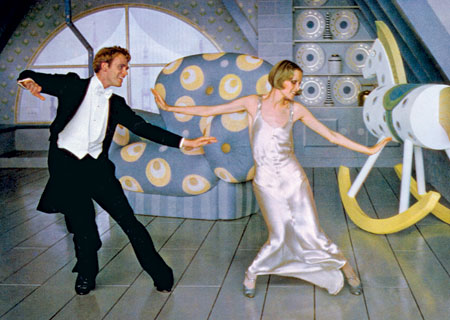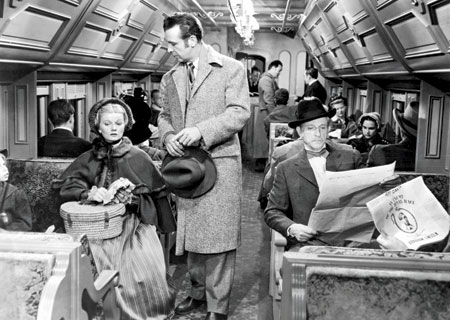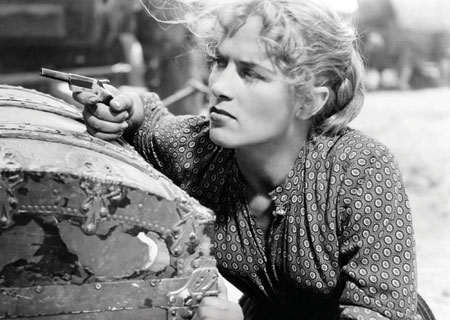DVD Classics
By Robert Abele
With the near extinction of repertory theaters where film buffs could once search out unsung chestnuts by important directors, the success of the Warner Archive vault-to-viewer service deserves a special shoutout. Recognizing that it owned a wealth of catalog material never released on DVD that wouldn’t merit a mass-market release to stores, Warner Bros. opened up its archives in 2009 with a manufacture-on-demand service that has so far freed over a thousand unsung films (and television shows) from obscurity. This is a mostly no-frills service and the Archive’s made-to-order DVDs are typically struck from best-available prints and offered without extras (usually for $17.95). The Archive, which houses 10,000 titles including RKO and pre-1986 MGM releases, shows groundbreaking initiative in fusing the on-demand business model with a repertory house sensibility, a public acknowledgement of sorts that the greatness of a studio’s past lies in more than just its most high-profile achievements.
 Ken Russell's The Boy Friend (1971)
Ken Russell's The Boy Friend (1971) The Archive announces online new titles every week, and has been a particular boon for specialty-minded cineastes eager to collect artifacts such as long-forgotten B movies, risqué pre-Code melodramas, and cult films from the ’60s and ’70s. But what’s been especially exciting is the curtain-raising showcase the Archive presents for little-seen gems from well-known directors. That means a chance to discover and enjoy Michael Curtiz’s early skill with spectacle in Noah’s Ark (1928), Sidney Lumet’s underappreciated romantic satire of the 1 percent Just Tell Me What You Want (1980), or John Frankenheimer’s debut feature The Young Stranger (1957), a still-trenchant, wonderfully sensitive examination of a turbulent teenage mind. Then there’s a crackerjack moral screed like Mervyn LeRoy’s Five Star Final (1931), in which tabloid editor Edward G. Robinson literally can’t wash his hands often enough as he destroys lives with a brutally intrusive series of newspaper articles.
Those who know Jacques Tourneur only as a master of suspense from such ’40s classics as Cat People and Out of the Past can discover that his knack for tension could be applied just as effectively to a homespun piece of Americana like the 1950 charmer Stars in My Crown, offered in a newly remastered edition by the Archive. Set in the post-Civil War South, Joel McCrea’s small-town parson handles a variety of dilemmas—typhoid, a brooding doctor’s religious skepticism, and most stirringly, a hooded white mob’s attempted lynching of a black sharecropper—with exquisitely timed patience and, when called for, righteously inspired moral strength. Fable-like but clear-eyed, it is in its own way as gripping an exploration of the nexus between faith and reason in a community as Tourneur’s legendary chiller I Walked with a Zombie (1943). As it turns out, Stars in My Crown—unassumingly powerful in the best Hollywood studio system tradition—was the director’s professed favorite of his films.
 Anthony Mann's The Tall Target (1951)
Anthony Mann's The Tall Target (1951) Similarly unsung due to the number of higher profile masterpieces this director turned out around the same time, Anthony Mann’s 1951 brisk B suspenser The Tall Target feels like a pivotal point between his early noir classics (T-Men, Side Street) and his famously complex ’50s portraits of the West (Bend of the River, The Naked Spur). Set in 1861, The Tall Target is a charged mystery taking place on a night train from New York to Washington, D.C. on which Dick Powell’s police officer believes is an assassin (or many) plotting to kill President-elect Abraham Lincoln in Baltimore. Mann pulls out all the noir stops—shadowy lighting, people who aren’t what they seem, and Powell’s hard-boiled performance—while simultaneously depicting in overheard conversations (and metaphorically in the shaking, rattling movement of the train) a hot political climate in a riven country. Mann makes the most of confined spaces where the upper hand can change on a dime. For example, there is a great shot in which a tight follow on Powell’s face scanning passengers shows his features suddenly change, before the camera edges down to reveal a gun in his back. For lovers of tense train films, The Tall Target is relentlessly nervy, clever entertainment.
Samuel Fuller, meanwhile, was all nerve as a filmmaker, never settling too long in one style or temperament, often within the same scene or moment of a film. His 1959 film Verboten!—the last feature RKO produced before it shut down, and barely seen since its initial release—is a choice Archive find. It’s a gurgling cauldron of post-World War II tensions in occupied Germany, obstinately honest about such topics as love among the ruins (in this case, between an ex-G.I. played by James Best and Susan Cummings’ Fraulein), a conqueror’s responsibility, and a defeated nation owning up to its past. When Fuller underscores a sniper attack with Beethoven, or plays Wagner over the introduction of neo-Nazi villains, the effect is undeniably pulpy—Tarantino before Tarantino. Fuller mixes actors with stock clips from the Nuremberg Trials and disturbing concentration camp footage, punctuated with his narration as a prosecutor. So when he boldly places an impressionable German teen caught up in anti-American terrorism at the trials, it’s as if the film is slapping us to our senses along with the boy. With the judicious use of newsreels in this sequence, Fuller pulls off the ingenious perspective trick of reminding us what’s unreal about studio moviemaking while making things alarmingly real for a fictional character going through a moral transformation. No one deserved an exclamation point in a title more than Fuller.
 Mervyn LeRoy's Five Star Final (1931)
Mervyn LeRoy's Five Star Final (1931) British director Ken Russell was another “out-there” visionary with a few hidden treasures available through the Archive, such as his 1972 arty biopic Savage Messiah (about sculptor Henri Gaudier-Brzeska), and—more thrillingly—his broadly delightful 1971 musical The Boy Friend. Giving Sandy Wilson’s 1954 stage hit a show-within-a-show spin, Russell nested the 1920s-pastiche story and songs within a backstage comedy about a seaside theatrical troupe (à la 42nd Street) and an understudy (Twiggy) taking over for an injured star (Glenda Jackson). Russell weaves a colorful collage of nostalgia, showbiz satire, and modernism by celebrating both the hammy personalities in mistake-prone amateur theater and, through fantasy sequences, the razzle-dazzle of film musicals from the Busby Berkeley era, complete with overhead kaleidoscopic shots of intricately fanned gams, elegant camera moves, and candy-coated sets and costumes. Russell even added two songs just for Twiggy, “You Are My Lucky Star” and “All I Do Is Dream of You,” as an homage to Singin’ in the Rain. And thanks to the remastered edition from the Archive, the visual flair and tuneful soundtrack fairly pop off the screen.
Russell’s warm upending of musical convention gives needed context to the often overheated lollapaloozas that earned him his reputation. That same kind of reappraisal can be had from viewing Blake Edwards’ overlooked 1971 Western Wild Rovers, another must-see in the Archive’s collection. Edwards had always liked moving between genres, but his reputation for comedy—from Operation Petticoat (1959) through his ’60s work with Peter Sellers—preceded him. After the expensive flop Darling Lili (1970), Edwards tucked into an elegiac Western he wrote himself about a pair of ranch hands played by William Holden and Ryan O’Neal who, almost as if they’d lived during an era when they could have seen too many movies, think they can rob a bank and go straight to life on Easy Street. It sounds like a typical Edwards comedy, and yet hardly anything about it is played for laughs, save for one telling Edwardsian gag involving the drunk, brawl-battered protagonists being carted out of town in a wagon, Holden saying it can’t get any worse, and a woman subsequently emptying her chamber pot over her second-story railing as they pass by.
Much of Edwards’ later ruminations on getting older can be traced back to this film, which is emotionally pitiless, even willfully pokey, about many typically mythologized Western conventions—outlaw behavior, open-range dying, the barroom brawl—yet it never feels like a revisionist take like Sam Peckinpah’s The Wild Bunch (1969). Rather, it’s as if the long takes, dissolves, dawn/dusk imagery, dark interiors, interrupted revelries, bursts of activity, and undignified ends add up to a cinematic hospital visit with a wheezing genre whose busiest days may be behind it, but still has just enough poetry to get you thinking about big themes such as fate and mortality. Although MGM cut much of the movie before release to Edwards’ dismay, what the Archive has is the director’s original roadshow edition. (Also available from the Archive is the movie Edwards made in response to his Lili and Rovers experiences in Hollywood, the scorching 1980 showbiz comedy S.O.B.)
 William Wellman's Westward the Woman (1951)
William Wellman's Westward the Woman (1951) Wild Rovers is, of course, thoroughly male in outlook, as most Westerns are. Which is why one of the Archive’s most valuable offerings is William Wellman’s 1951 wagon trek drama Westward the Women. Inspired by a story Frank Capra gave to Wellman, the film traces the arduous mid-19th-century journey of a group of marriage-ready women across half the country to a California ranch, where companion-less men eagerly wait. Their guide is a surly, misogynistic trail boss (Robert Taylor) who sees the entire enterprise as foolhardy. Along the way, however, the determination and grit of the women, who soldier on even after the men in Taylor’s crew abandon the trip, change his mind.
For a genre long accustomed to rugged adventure for the male roles while women are relegated to playing silently suffering homesteaders or prostitutes, the physical, often fatal, hardships that pile up for this intrepid band of distinctive female characters (their story presented with virtually no musical underscore) become in the notoriously macho Wellman’s hands a fascinating, stirring depiction of female fellowship unusual for a studio Western. (The production used up practically every available Hollywood stuntwoman.) Wellman spares little in laying out the grittiness of it all, and after one especially brutal attack by Indians, during which the women valiantly defend their wagons, Wellman serves up one of his finest sequences ever: a stark, moving roll call of the dead in which the women individually shout out the names of the fallen, their voices augmented by a haunting echo that speaks volumes about the severity of the frontier mindset. What makes Westward the Women even more special as an addition to anyone’s collection is the fact that it carries a rare DVD extra for an Archive offering—a commentary track by film historian Scott Eyman.
If the pioneer spirit is what Westward the Women makes masterfully resonant, it’s only fitting that its renewed availability comes courtesy of the similarly pioneering Warner Archive. And if in Hollywood the best sign of success is to see who’s hitching their wagon to your star, take note: Universal, Sony, Lionsgate, and MGM have launched their own archival movie-on-demand services. Onward, to the vaults!